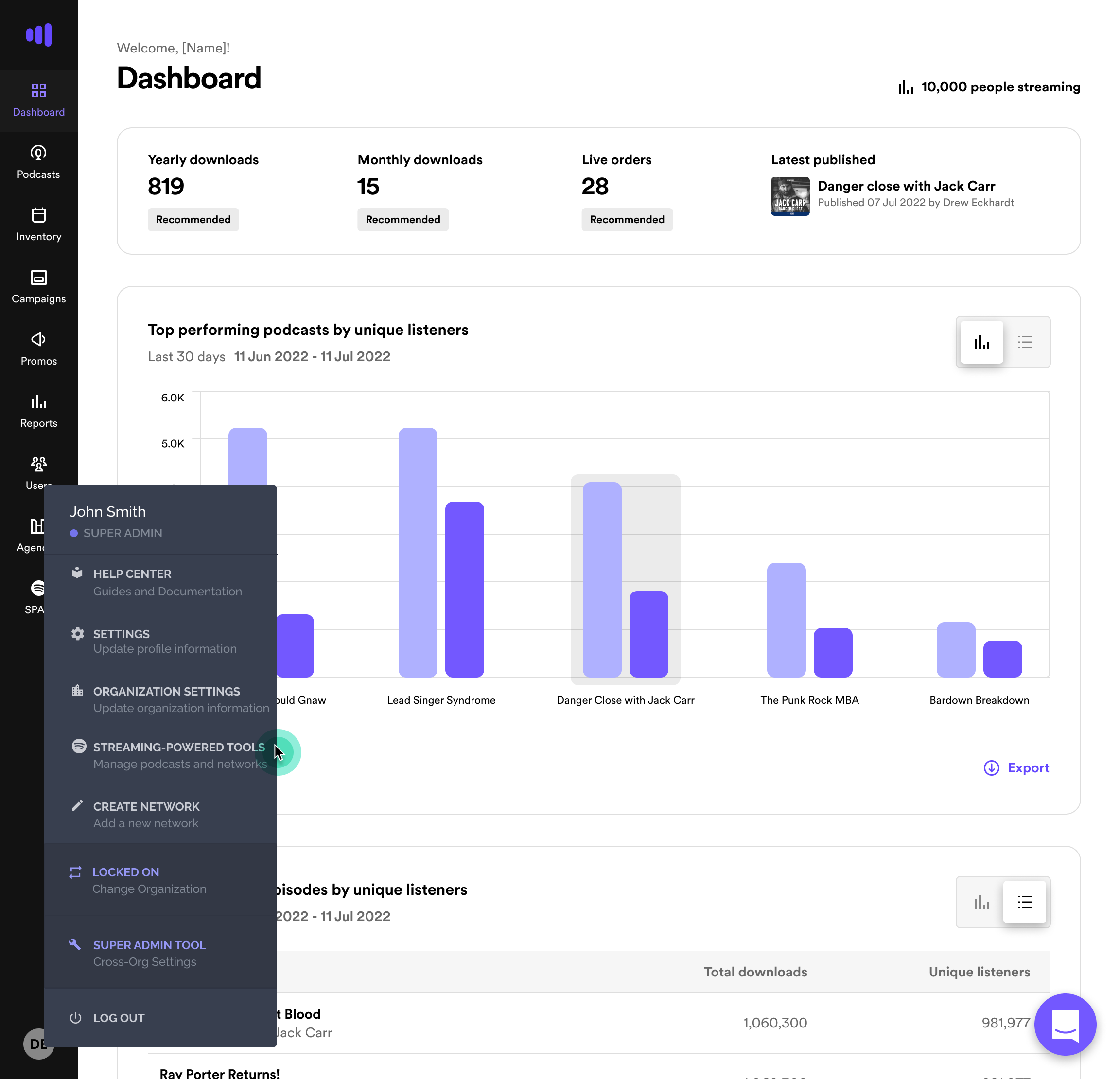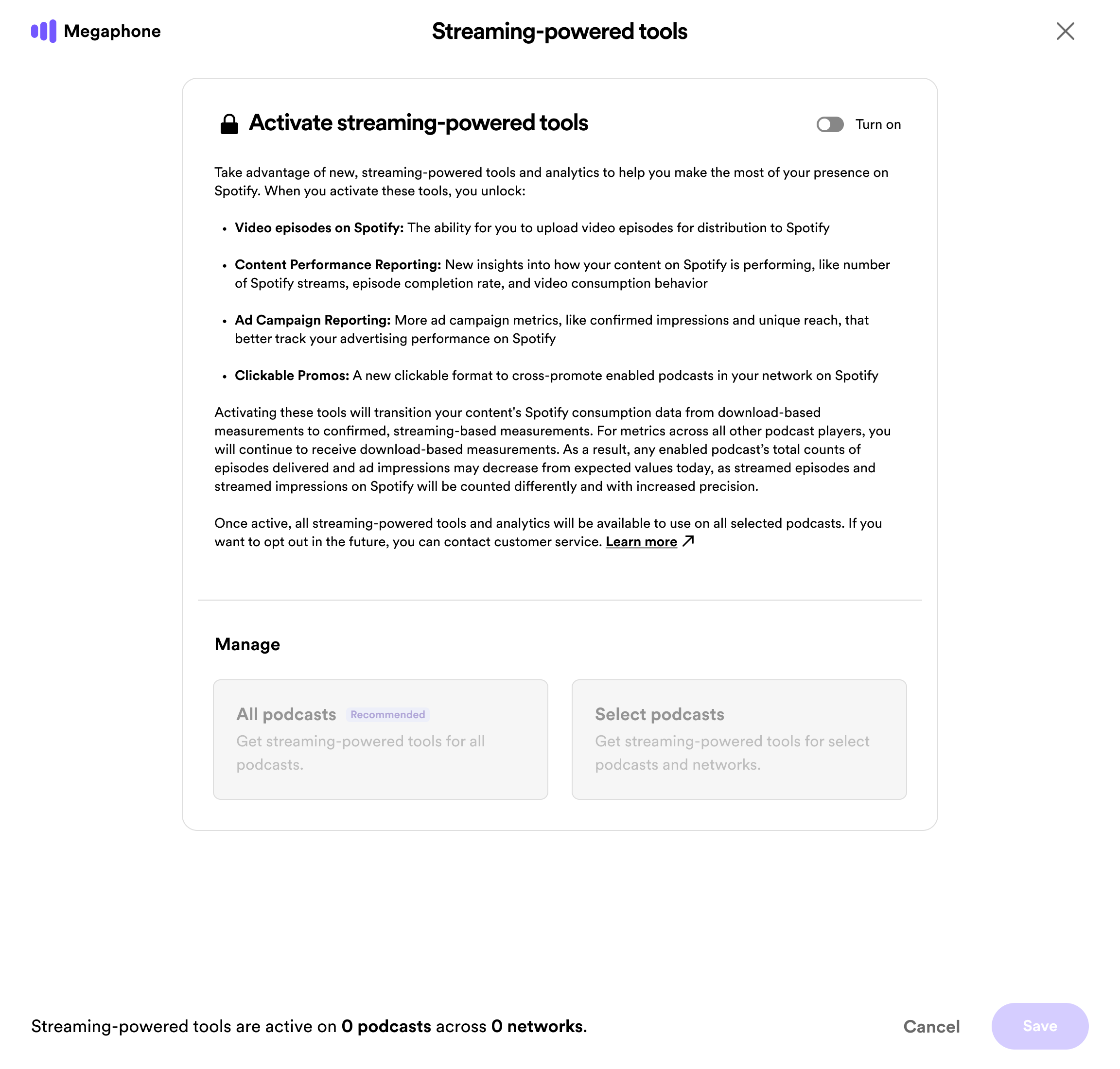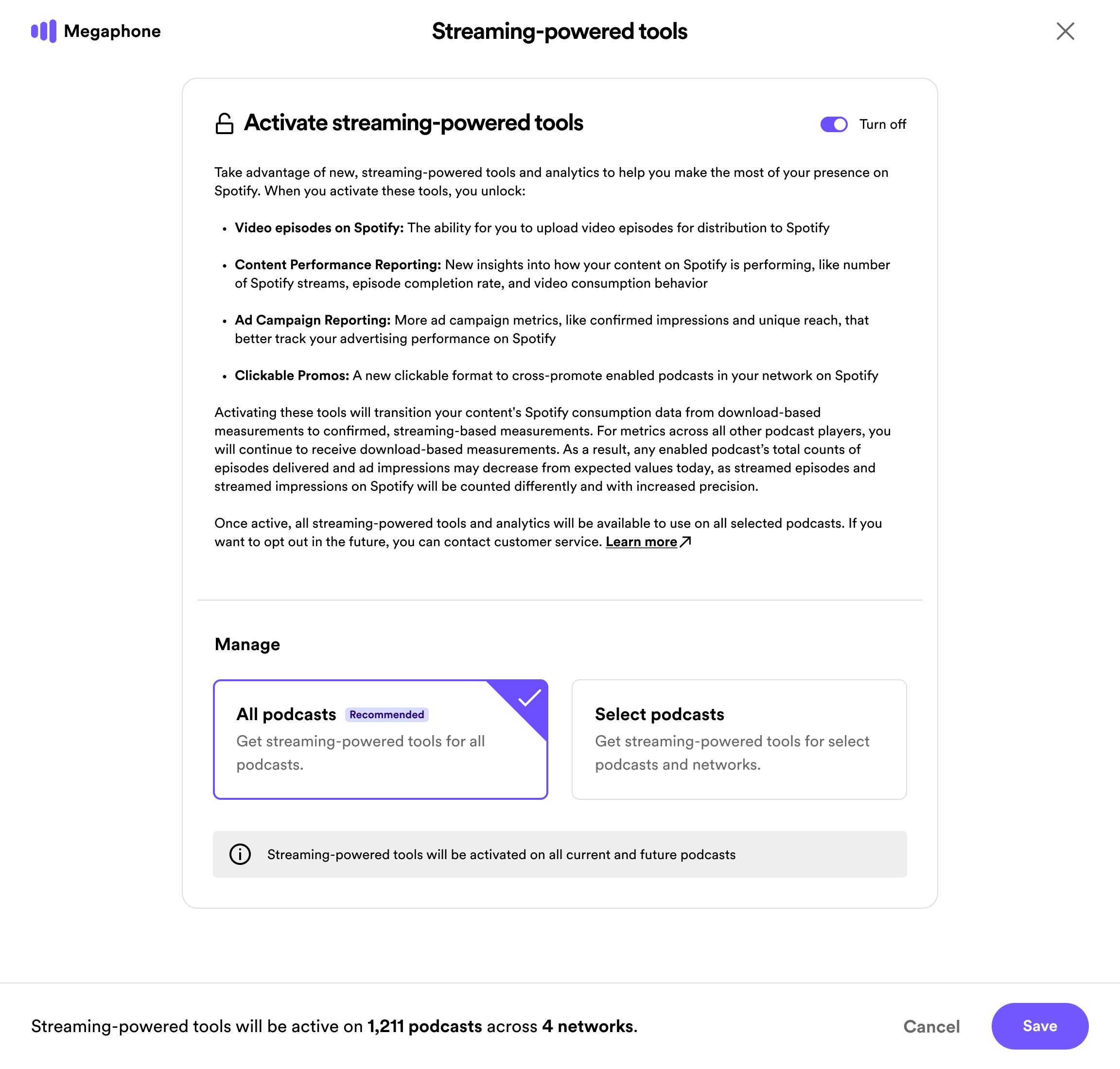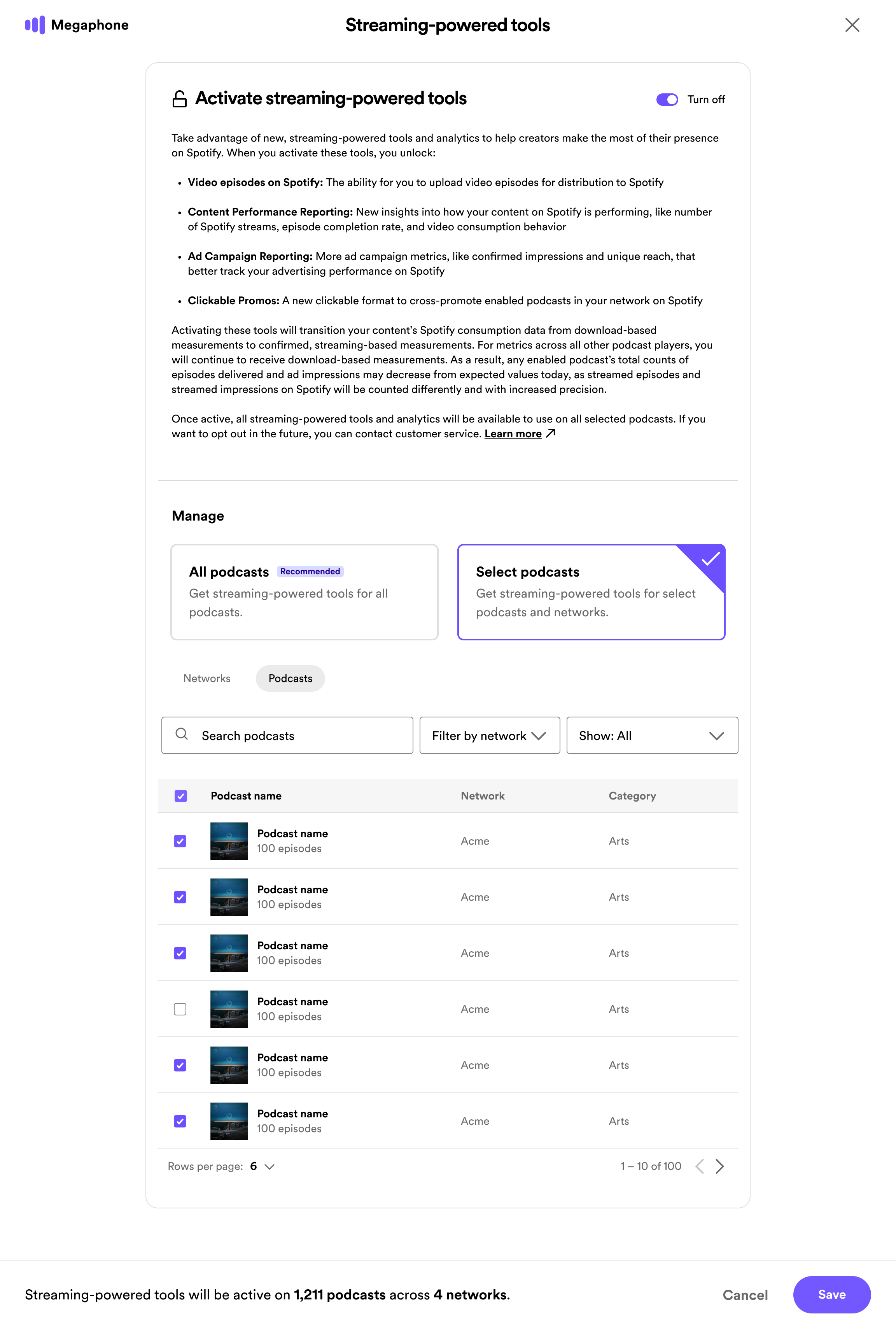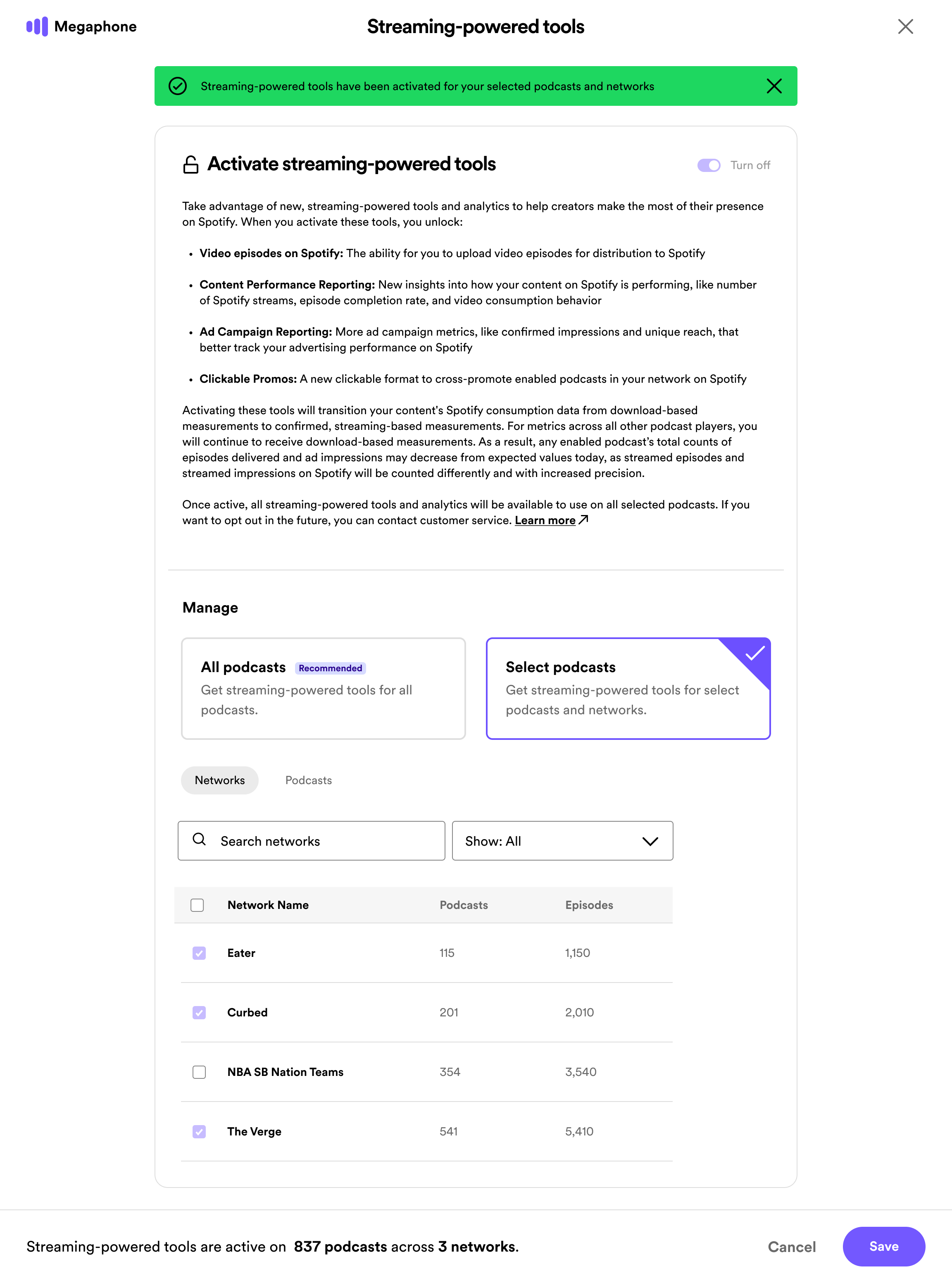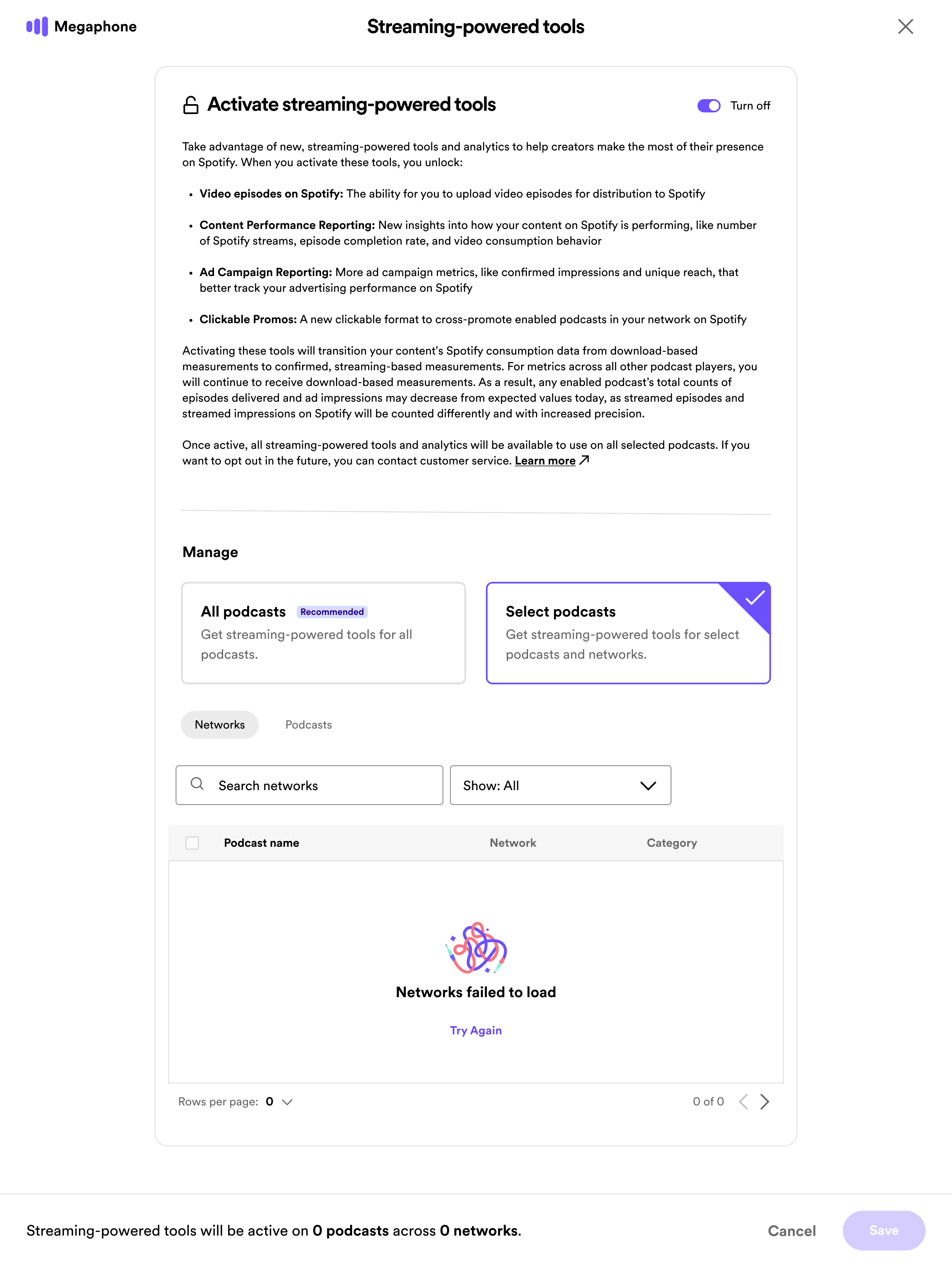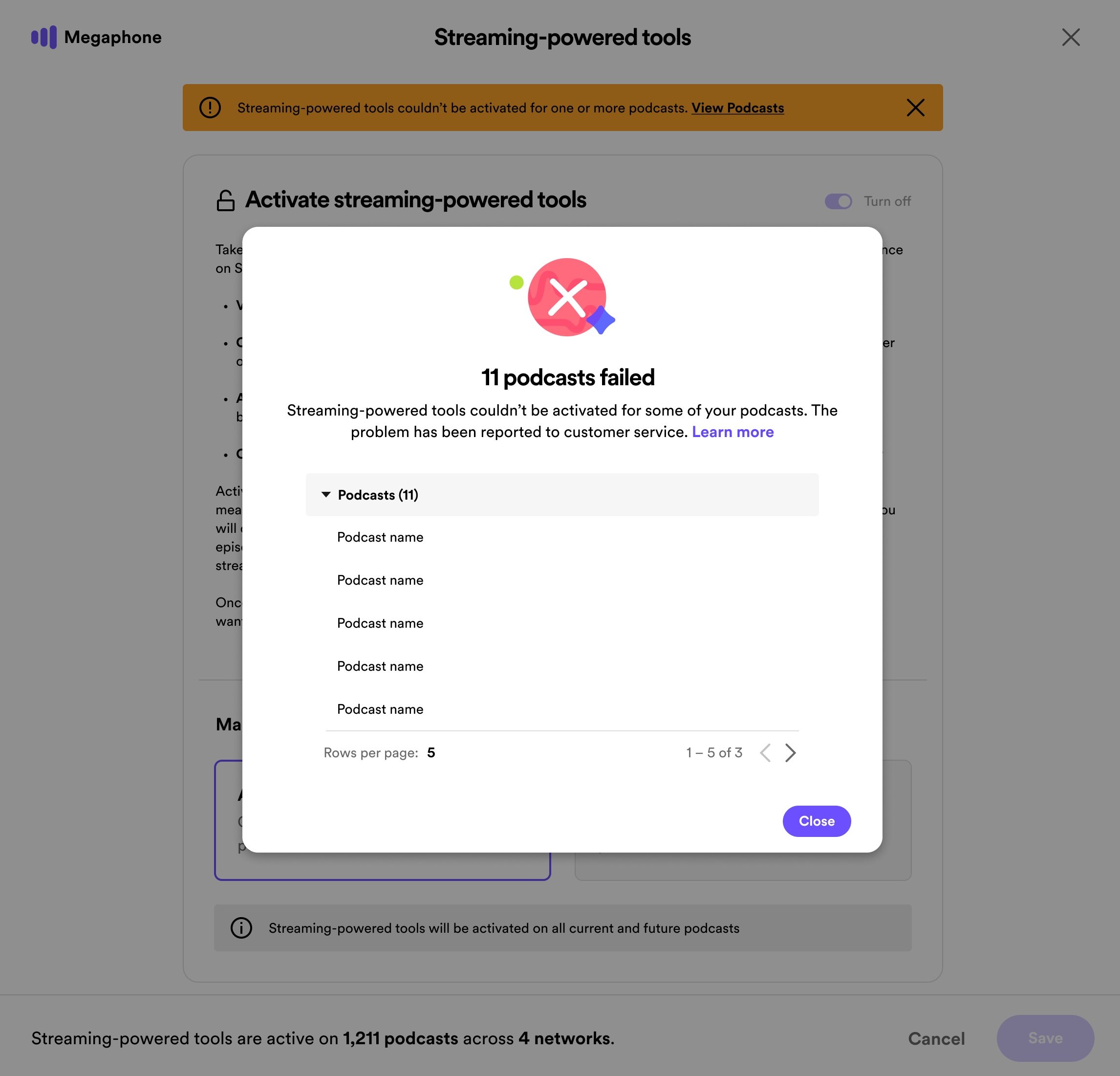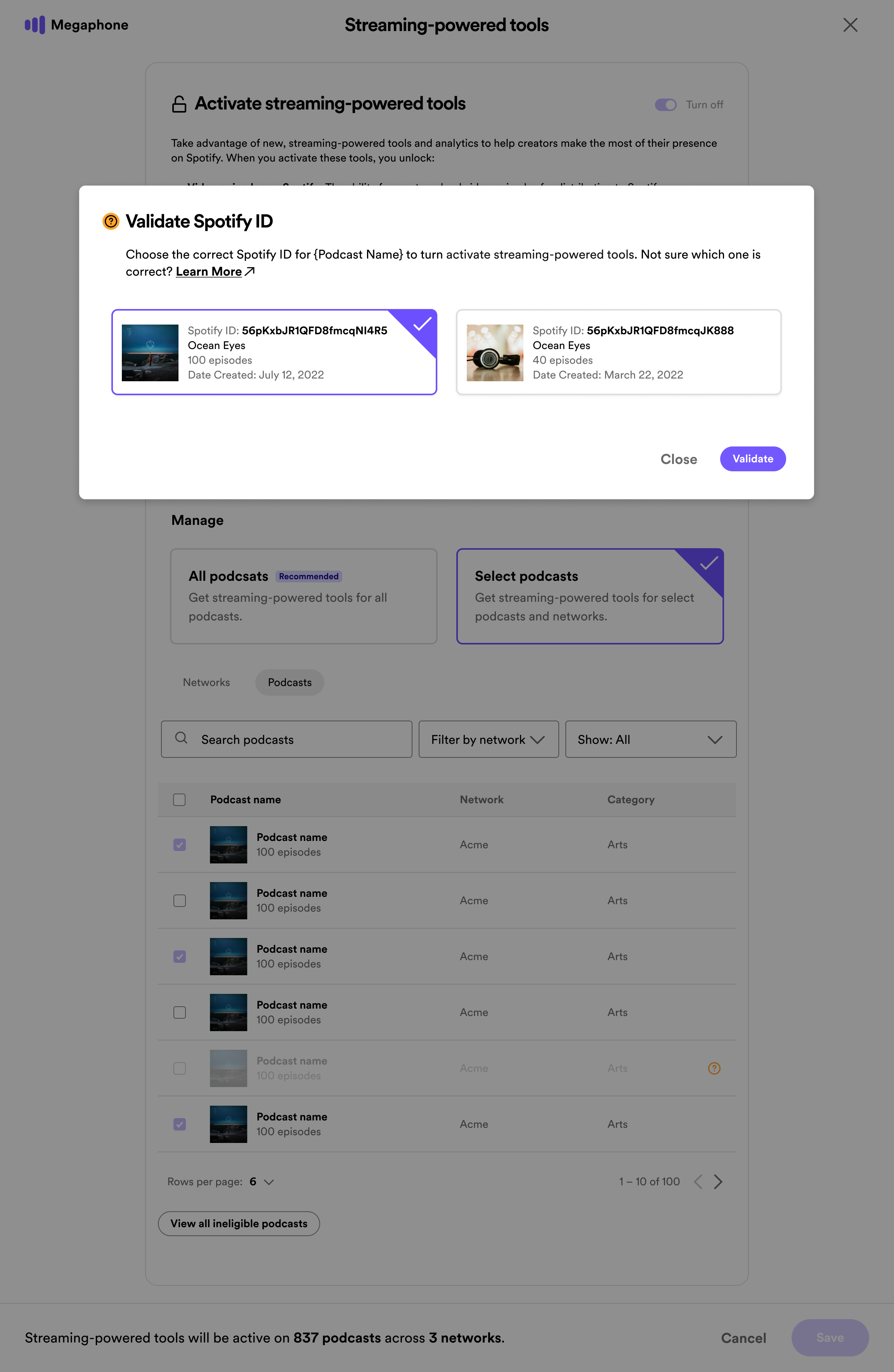Spotify streaming-powered tools
Streaming-powered tools is a suite of podcast publishing capabilities fueled by Streaming Ad Insertion (SAI) technology. Megaphone publishers can opt-in to the suite to take advantage of the power of streaming on Spotify.
The suite is currently made up of 4 features:
Video episodes
Allows users to publish and monetize video episodes on Spotify directly through Megaphone
Call-to-action cards
Allows users to add interactive display units to audio ads
Content performance analytics
Gives users access to streaming metrics like video completion rate, average watch time vs. listening time, and audience insights
Ad performance analytics
Gives users to access to streaming metrics such as ad completion rate, reach, frequency, and audience insights
-
Lead Product Designer
-
Strategic vision
Product design
Project management -
Product Management
Content Design
Engineering
Marketing
Customer Success
User Research
Data Insights
Onboarding Modals
Contextual Call Outs
Context & Business Problem
Historically, in the podcast industry, publishers publish their podcasts by uploading audio files that use Dynamic Ad Insertion (DAI) technology, which measures activity when a listener simply downloads the podcast episode. This presents a problem because this shows intent but not execution. DAI often overestimates impressions. After all, a listener may download a podcast and never actually listen to it. Until now no one in the industry had the advanced technology to understand if the impression was true. Spotify’s introduction of Streaming-powered tools via Streaming Ad Insertion (SAI) technology delivers real-time, accurate impressions, and unlocks new content formats like podcast video episodes, call-to-action cards, and advanced analytics that prior to this launch had never before been available. After all, Spotify is the number one streaming platform.
User Problem
Publishers want more accurate audience data and access to new content formats like video and call-to-action cards and advertisers want more accurate ad performance metrics to grow their business. With Streaming-powered tools, we have an unique opportunity to provide our listeners with the content they desire and our publishers with the tools they need to grow their audiences and increase revenue – all in one place.

Challenges
Introducing new technology
DAI (downloaded-ad insertion) often over-estimates impressions whereas SAI (streaming-ad insertion) delivers real-time, accurate impressions. This meant publishers' performance metrics would seemingly dip while transitioning to SAI, causing frustration and doubt.
A top 10 Bet at Spotify
Streaming-powered tools was a top 10 priority for the whole Spotify org. While this was an amazing opportunity it also meant a level of external communication outside the working group was required consistently and widespread. On the flip-side, we got a unique and invaluable opportunity to present to C-level leaders and get rapid feedback for iteration.
Collaborating across multiple teams and cross-functional partners
Streaming-powered tools was a major undertaking that spanned across almost every squad on Megaphone. I was tasked with leading this initiative from a design standpoint and delivering experiences across the enablement of SAI and video podcast episodes on the platform. While leading the collaboration across the entire delivery of this workstream. We also forged new relationships and collaborated with many cross-functional partners such as marketing, user research, engineering, and product in order to gather the right knowledge and expertise.
Handling technical limitations
Launching a new product offering that runs on new technology is no easy feat. Our engineers were working overtime to meet ever-changing feature requirements. At times, the product team reduced certain feature functionality to meet deadlines. These cut-backs often impacted the overall integrity of design’s vision.
Alpha Experience
Prior to me joining Spotify and leading the project, streaming-powered tools was in it’s alpha iteration. It was available only via white-glove service with customer support, without additional content formats or in-app advanced analytics. Analytics were delivered manually to users via email. The process to enable was extremely difficult and complex.
Opportunities
I facilitated multiple x-functional workshops to identify our key opportunities, the challenges we will face and how we could overcome them, our design approach, the full scope end-to-end of streaming-powered tools, and a glance into the future.
Specific
Premium Content & Distribution
How might we offer additional foreground experiences with streaming-powered tools to increase engagement? And how might we build a repo of premium content to get more ads revenue?
Understanding and Growing Audiences
How might we offer users an opportunity to reach new audiences and improve the discoverability of their content with streaming-powered tools?
Prove Advertising Value
How might we prove the value of streaming-powered tools through ads performance and drive ad relevance?
General
Compelling Product Offering
How might we offer users enough benefits to enhance and grow their businesses and minimize the natural impression loss that occurs when going from Dynamic Ad Insertion to Streaming Ad Insertion?
Self-service
How might we create a self-service experience and have streaming-powered tools easy to understand and enable?
The Nudge
How might we leverage the behavior psychology principle of “the nudge” to get more users to turn on streaming-powered tools? Which proposes adaptive designs of the decision environment (choice architecture) as a way to influence the users’ behavior.
“The Road to Streaming-powered tools”
Design Approach
Provide Guidance
At every step of the way we should be guiding the user towards the most positive outcome for their business, helping them understand the process and the potential outcomes. Bring information in context of their JTBD.
Be Flexible
We are dealing with more than one primary user and they do not have the same needs and we need to be aware of that, our designs should reflect flexibility empowerment and control for our users.
Make it Easy
Increase ease of use to allow for fewer barriers to entry to get more engagement for a complex product model and offering.

Conceptual Development
This project was a large multi-team effort. As the design lead, I was to oversee and support all the various work streams and efforts and deliver the solution for enabling streaming-powered tools and video podcast episodes (which I share in the next case study) in collaboration with another designer, content design, and research support.
Below are early explorations for the streaming-powered tools solution.
Early iterations of Onboarding
Onboarding and learning is responsible for converting Megaphone users to streaming-powered tools users.
Early on in the project, we knew we would need to spend a lot of time working on the guidance and education of this suite of products and be very intentional about how we packaged these features. The path to streaming-powered tools is complex: requiring multiple in-platform touchpoints to gain trust, communicate benefits, and ultimately lead us to vast publisher adoption.
This work included two flows. Pre-enablement education which drives awareness and adoption, and post-enablement education which focuses on optimization and onboarding users to their new suite of features.
Intro Modal
-
-users will not immediately dismiss the onboarding intro modal
-we will be able to explain the user value in this context
Intro Banner
-
-the intro banner will be engaging and informative enough for users to enable streaming-powered tools
-users will trust Megaphone and Spotify with their business to try something new
Info Email
-
-The marketing email will reach the decision-maker
-the content strategy will be compelling enough to get conversions
Early iterations of Opt-in
Streaming-powered tools is accessible to organizational administrators via org settings.
Enablement is entirely self-serve, eliminating a 7-step, manual process for our CX team.
Users have the option to enable all podcasts or select podcasts, bringing additional flexibility to our users.
Contextual callouts to add/adjust any missing requirements blocking podcast opt-in gives the user full agency over their media.
Org Admin Settings
-
-users will associate turning on streaming-powered tools with managing their settings
-adding suite features info in settings will bring more contextual association
Default Modal
-
-defaulting to users’ entire library will result in more SAI enabled podcasts
Custom Modal
-
-users will want the ability to turn on SAI for only a subset of their library for A/B testing performance and access to new features
Research
5 User sessions
4 org admins
1 ad opts
Research Goals
Product Positioning - Understand how to position the benefits of streaming as a critical need (not just a nice-to-have/experimental) in a way that feels like an evolution/enhancement to current-state download-based podcast content/promo/ads.
Evidence & Education - Understand what claims would be most salient to publishers? What would help them tolerate the risk of switching and the operational burden of navigating two currencies?
Commercialization - What are value-maximizing ways to offer streaming products to publishers and where/how throughout the publisher user journey should we feature positioning and evidence?
Research Insights
-
Overall the sentiment of first-time introduction to streaming-powered tools was positive. Publishers feel it was well designed and are interested in the features it unlocks.
-
What is going to happen when SAI gets turned on and why?
The statement caveating impression change does not stand strong enough on its own and as we expected raised publishers’ eyebrows. Publishers wanted to know more about the change in impression, but also wanted to better understand why, as well as information on their ability to turn off SAI if they needed to. There is an appetite for a link to FAQs.
What exactly is [it] and specifically more details regarding the individual features and why we should want them?
Information on this page piques interest but doesn’t tell enough of the whole story for publishers to feel ready to opt in on the spot. Publishers want to be told why they should want these features. There is a need for more explicit and detailed feature descriptions and across both categories an appetite for FAQs or Instructions.
While publishers know they can get this information elsewhere, including talking to Megaphone reps, they feel it is important to have this information at the point of decision.
-
‘Go To Settings’ doesn’t resonate as the natural next step
Publishers only knew to click on ‘Go To Settings’ button as it was the “only choice of button” to move forward with. Publishers did not understand why they would “need to ‘go to settings’” to learn more about this offering or to bring them further along in the process. They strongly felt the button should not say “Go to Settings” but rather something more specific like “Learn More”.
Information shared as a first-time pop-up is good, but not enough by itself.
Sharing this information as a first-time pop-up is received well, but publishers expect this information to be available elsewhere in case they have to X out. Often times publishers will pop into Megaphone with a job to get done and are more likely to X out of notifications due to inconvenient timing and not lack of interest. They need to know where they can find this product information again.

Final Design Snapshot
After the research sessions and multiple rounds of peer and leadership critique, we iterated again multiple times to land on a solution for onboarding and enablement for streaming-powered tools. A snapshot of the solution is below.
Organization Admin - Dashboard Modal / Introduction to Streaming-powered tools *Based on research: edited CTA language
Organization Admin - Producer requested admin opt into streaming-powered tools
Producer dashboard banner
Contextual streaming-powered analytics call out
Video episode contextual call out
Streaming analytics contextual call out
Changed the information architecture and moved Streaming-powered tools to user settings menu once the product team decided only an organizational administrator could enable this suite of products. *We learned in research users wanted an easy way to access this information after their first introduction.
Streaming-powered tools / default setting *Based on research added more context to this product suit at the point of user decision.
Streaming-powered tools on / full library enabled
Streaming-powered tools / select podcasts enabled
Streaming-powered tools / missing requirements
Streaming-powered tools / success banner
Streaming-powered tools / network failure
Streaming-powered tools / podcast failure
Streaming-powered tools / multiple Spotify IDs
Prototype
Happy Path, User: Org Admin, 1st log-in
Results
LIVE - As of June ‘24
4000 podcasts, 200 publishers opted-in to streaming-suite
628 million+ streaming impressions
250,000 video episodes published
170M users watching video podcast episodes
1.5 million clickable promo impressions



















